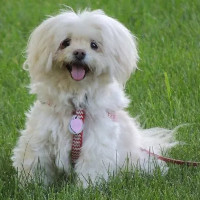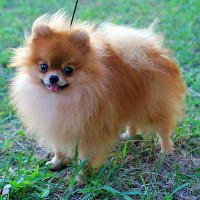Appearance of the Pom-Coton
|
| The Pom-Coton, a hybrid mix of the German Toy Spitz / Pomeranian and the Coton de Tuléar, can inherit appearance traits from either parent breed. Your Pom-Coton will probably measure between 7.5 and 38 centimeters at the shoulders and weigh between 3.5 and 5.5 kilos. He may have a long, fluffy coat with or without undercoat, coat colors may be white, white with gray or iron-red markings, black, black and tan, blue, blue and tan, chocolate, chocolate and tan, cream, sable cream, orange, sable orange, red, sable red, sable, brindle and white with different types of markings. His tail will probably be curled over his back to some extent and fluffy, his dark, shiny eyes and black nose on a straight muzzle with a scissor bite will complete his alert, inquisitive expression. |
Temperament of the Pom-Coton
|
| Your Pom-Coton hybrid, being a mix of German Toy Spitz / Pomeranian and Coton de Tuléar, may inherit temperament traits from one or both parent breeds. Your hybrid will be loving, affectionate, alert, loyal, intelligent, outgoing, playful and social. As with almost all canine breeds, early socialization is recommended. With proper early socialization, he'll get on well with children, other dogs and even the family cat. He may be a little wary of strangers, getting this trait from the Pom parent, but the accessible trait brought by the Coton parent can modify this. It's important to remember that your hybrid is highly intelligent, and this intelligence leads to training problems. That said, the Pom-Coton should be fairly easy to train, provided your training periods are short and you incorporate plenty of fun. A bored dog can develop very annoying destructive behaviors if not sufficiently engaged mentally and physically. |
Needs and activities of the Pom-Coton
|
| Your Pom-Coton is a moderately active dog. He will need 30 to 60 minutes of daily exercise. This exercise can be accomplished with daily walks, interactive retrieving and Frisbee games, exploration and play in the dog park or fenced-in backyard, and romping and retrieving-type games in the house. Your Pom-Coton, being small in size, can easily be adapted to apartment or condo living as long as his exercise needs are met on a daily basis. He can also live very well in a family home with or without a fenced yard, whether in an urban or rural setting. It will probably tolerate moderate climates, with extra protection provided in the hottest and coldest extremes. |
Maintenance of the Pom-Coton
|
| Your Pom-Coton hybrid, being a mix of German Toy Spitz / Pomeranian and Coton de Tuléar, is a breed that may or may not be hypoallergenic, as this trait is only contributed by the Coton parent. This hybrid is considered to be in the moderate maintenance category, its long, dense coat requiring brushing two to three times a week to remove mats, debris, loose hairs and distribute oils throughout the coat. He will probably be a weak to moderate excretor and low in the drool and odor category. Your hybrid's ears should be checked weekly and cleaned as needed with a cotton ball and an approved canine ear cleaning solution. Be sure to check his nails once a week and trim them if necessary. As with most dogs, attention to dental health is also important. Brushing his teeth two or three times a week and following routine dental examinations and cleanings with your veterinary professional will help prevent the development of periodontal disease and the tooth loss that accompanies it. |









 English (United Kingdom)
English (United Kingdom)